3D scanning is deeply connected to 3D printing, but at the same time, it’s an independent field that benefits from advances in fields such as computer vision, reconstruction algorithms, and sensor technology. In recent years, it has improved greatly in terms of quality and usability and become viable for use among hobbyists or home DIYers.
In a nutshell, 3D scanning is the set of techniques used in order to “digitize” a physical object and transform it into a 3D file, which can later be edited. It all begins with a suitable scanner, although alternatively, you can use the power of the camera on your smartphone to do the work for you through photogrammetry.
However, simply having a good scanner isn’t enough; you’ll also need good software in order to complete the scan. The scanner on its own can usually only produce a set of raw points; it’s the software and underlying algorithms that will determine the final quality of the resulting mesh.
There are many choices of 3D scanning software out there and it can be a daunting task to find the best fit, so we’ve compiled a list of software that you can download now and start scanning! Before we take a look at the options, let’s go over a few things you may want to keep in mind when deciding on the one that will best meet your needs.
Considerations
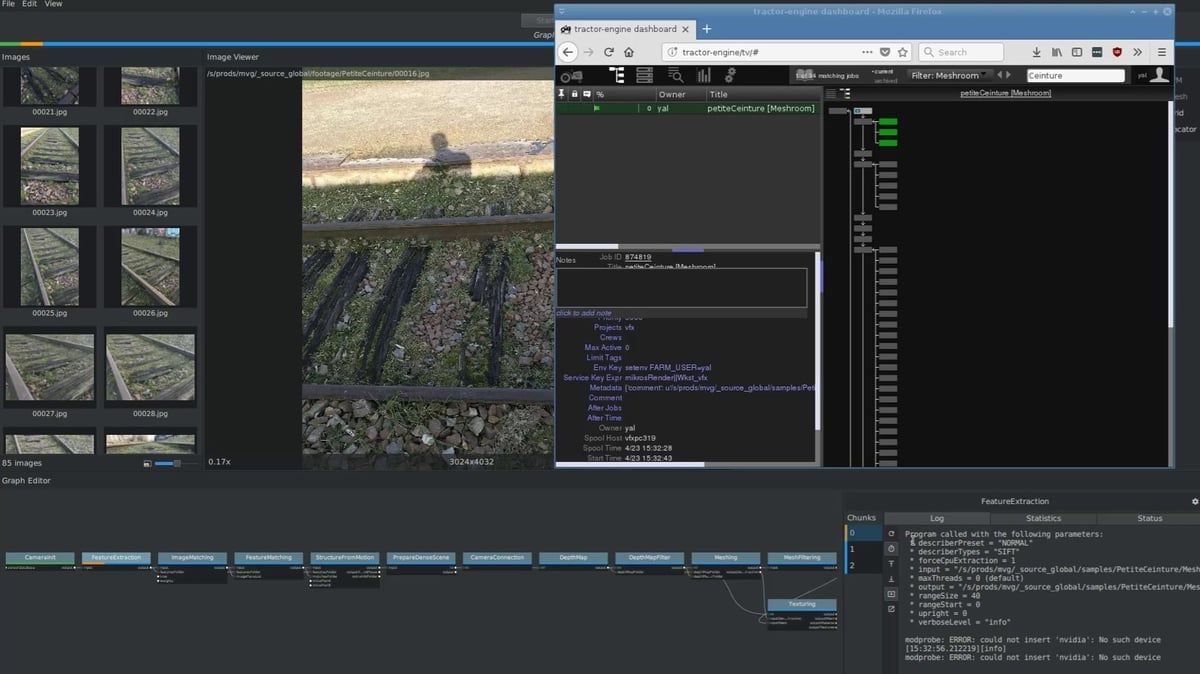
Given the number of 3D scanning software options out there and how many features and tools they have to offer, it’s useful to know that the main functions of software during the scanning process are:
- Optimizing based on available hardware
- Creating a process workflow
- Organizing photographic data
- Recognizing and computing textures
- Responding to real-time changes in the working environment
- Reconstructing the real object digitally (depending on scanning technology)
- Correcting, cleaning, and noise reduction in the final mesh
Since the above list is a bit long, we’ve condensed it into the following points as guidelines for what to look for in scanning software, which are items to consider depending on what you need:
- Speed and accuracy: How fast and well can the software reconstruct real-world objects? (Especially important when scanning objects with tiny details or difficult regions such as holes.)
- Color fidelity: How accurately can the software determine the color of an object?
- User-friendliness: How easy is the software to use? How long does it take to learn important features?
- Export capabilities: What types of files can the software export? (Important if you’re working on another platform later.)
So, without further ado, let’s check out the options!
Free
To start with, we’ll go over some great free options that may offer a few more paid features – but the app itself works without needing payment. These are great options if you’re just getting started or want to try out different programs before committing to one.
Meshroom

Meshroom has been around for quite some time. It’s the brainchild of several European academic research groups and subprojects, starting as part of the quest for an easier and feature-rich software environment for photogrammetry. They created the AliceVision framework in order to process and reconstruct scenes using photogrammetry techniques.
Meshroom is the free and open-source graphical user interface of AliceVision. While it’s quite simple and straightforward, there’s still room for improvement. The user has to load all pictures of the object that are available, hit “Start”, and wait for the results of the calculations.
Among the strong features of Meshroom are the different reconstruction modes that can be used and the analysis of each phase, which combined with the live preview feature, gives you a lot of control over your models. Equally useful is the ability to add extra pictures to a semi-finished project, which saves time instead of having to redo all the calculations. Texture handling is also good, as long as the surface isn’t too glossy.
One downside is that because there are no scaling options, and you can get really large physical objects reconstructed very small. But this is something easily fixed. (The speed of reconstruction is affected by the size of the object and the number of pictures inserted.) A more significant downside is the requirement for a CUDA-compatible GPU. And as for compatibility, Meshroom has a plug-in that works with jack-of-all-trades Blender.
- Price: Free
- Application: Photogrammetry
- Learning curve: Medium
- Strong points: Live preview, nice features
MicMac
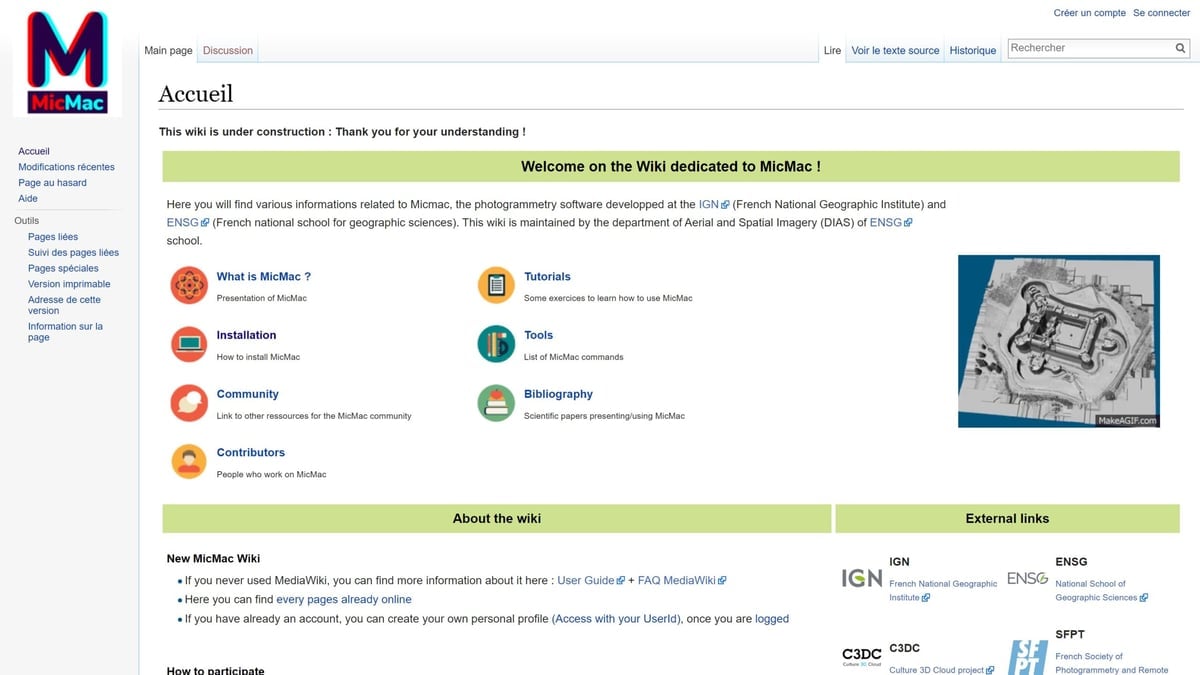
MicMac is another open-source software dedicated to mesh reconstruction from datasets created with photogrammetry. Its target audience is a bit more towards the scientific and academic space, which makes sense given its creators are the French bodies of the National Institute of Geographic and Forestry Information and the National School of Geographic Sciences.
One of its strengths is that thanks to its modules, MicMac can be used for a variety of real-life reconstruction applications like cartography, environment, industry, forestry, heritage, and archaeology.
Although its command-line based UI looks a bit old-fashioned, MicMac lets the user take control whenever desired. Its strength lies in the ability to adapt to the type of user. Advanced users will love the ability to set and experiment with every possible parameter, even at intermediary stages of data analysis or calculations, thanks to its use of open data formats. The more inexperienced users will find it convenient to just use the commands with their default values.
Some other unique features that MicMac offers compared to other similar software are the possibility to create orthoimages, the number of calibration presets for different cameras, the processing ability for analog images, and statistical indexes to conduct qualitative evaluation of the results. Additionally, the processing speed for various tasks is above average compared to other software.
- Price: Free
- Application: Photogrammetry
- Learning curve: Medium
- Strong points: Versatility
OpenMVG
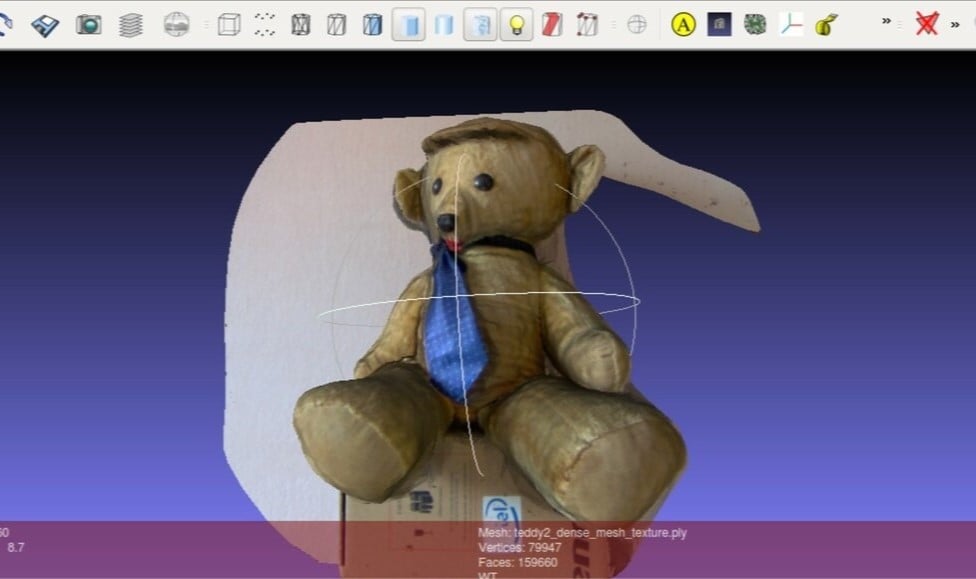
OpenMVG originates from academic environments and could be better described as a library of tools and algorithms related to the field of computer vision. Since 3D scene reconstruction uses a lot of tools from this field, OpenMVG tries to bridge that gap and offer a comprehensive solution. Therefore, it’s no surprise that this program is quite popular among researchers.
It tends to support the “structure from motion” technique, where features of consecutive oriented images (taken from different angles and sides of an object) are associated with common features. The reconstruction process attempts to analyze different images and construct a “map” of relations between them, either through their metadata or through the view of the camera.
Images that have been taken from the same point but differ in angle can be used to infer and extract distances and edges. OpenMVG also provides algorithms to reduce the noise from images, in order to produce more robust datasets.
- Price: Free
- Application: Photogrammetry
- Learning curve: Hard
- Strong points: Access to many parameters
Paid
The following programs might include a free trial or version, yet the latter may not offer enough features to justify it being included in the previous category. And there are also a few professional heavyweights.
Canvas

Canvas is a 3D scanning app that can be downloaded for free on an iPhone or iPad. It’s designed to scan large spaces, allowing users to make digital versions (2D or 3D) of rooms in a matter of seconds.
Canvas is a helpful tool for anyone who needs a digital model of a building. Its scans are 99% accurate, thanks to the lidar feature in devices compatible with the app. These scans can then be exported as CAD models to other platforms such as SketchUp or AutoCAD, providing an easy way to visualize how potential renovations will look. An alternative is Canvas Measurement Reports, which makes a floor plan of a scanned area and includes key measurements.
While the app is free to download, exports from Canvas will cost $0.12 to $0.18 per square foot (depending on format) scanned, with a minimum total purchase of $20. This makes Canvas great for those who want an accurate scan of a room but don’t necessarily want to buy expensive software.
- Price: Free to download; 2D plans for $0.12 per sq. ft, 3D plans for $0.18 per sq. ft; Canvas Measurement Report for $0.18 per sq. ft
- Application: Photogrammetry
- Learning curve: Easy
- Strong points: Fast, accurate
Skanect

Structure’s Skanect is software that’s meant to introduce people to the art of 3D scanning by repurposing sensors and cameras from various devices. It’s entry-level software that enables the user to capture an object and do some basic editing of the captured scan. You can then share or upload it to a platform such as Sketchfab for further editing, or export it in a popular 3D format like STL, OBJ, PLY, and VRML.
While the quality of the scans always depends on the quality of the sensors (like Structure Sensor Pro), Skanect tries to provide a complete solution for the scanners mentioned above based on some entry-level sensors.
Typical uses of Skanect include full-body scans, scanning the exterior or interior of houses, and scanning small everyday items or even animals.
- Price: Free for non-commercial users (with limited polygon export); ~$129 for the Pro single license version
- Application: Photogrammetry, laser-scanning (Kinect)
- Learning curve: Easy
- Strong points: Ease of use, compatibility with common devices
RecFusion
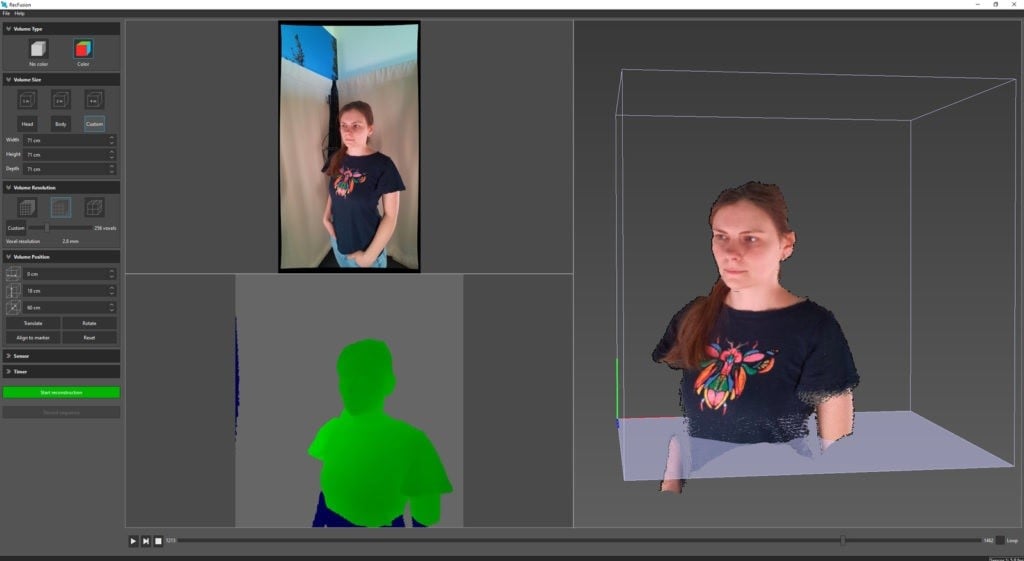
RecFusion uses depth sensors, such as the Microsoft Kinect, Asus Xtion Pro Live, and the Intel RealSense, in order to reconstruct scenes, mainly of people and environments.
It comes in three versions: The single-sensor standard version is more suitable for scanning enthusiasts whereas the Pro version (multi-sensor) is better for the professionals. One step higher than Pro is the premium SDK version, which includes both single- and multi-sensors, and also integrates real-time 3D reconstruction directly into your application.
Its UI is neat and simple. All the main functions and parameters are on the left side of the workspace, the live image from the sensor(s) is in the middle, and the live preview of the object being scanned is on the right. Also, it’s possible to change the parameters of each sensor and observe the differences in the resulting mesh.
You can try to correct any errors in the initial scans by rescanning certain areas. Reconstruction can be either “live” or “offline”, meaning that the software provides the opportunity to save everything and process all captured data afterward.
The usual editing features are available, like cropping, selecting, and erasing unwanted elements. A feature that might displease some is the fact that apart from the brightness, contrast, and gamma, color can’t be edited separately (color information is locked during the initial scan). Exporting options include the most popular 3D formats, including STL and OBJ.
- Price: Standard (single-sensor) version is ~$180; Pro version is ~$620; SDK version is ~$750
- Application: Photogrammetry, scanning
- Learning curve: Easy
- Strong points: Support for various depth sensor models
Artec Studio
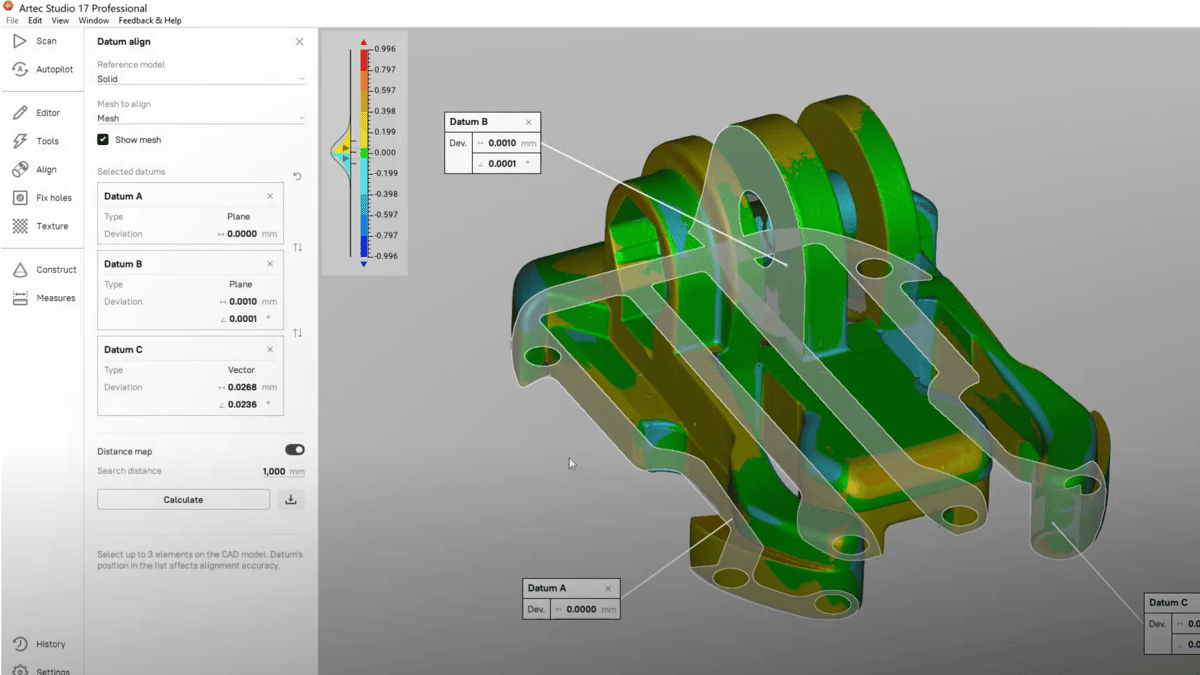
Artec Studio is software offered by Artec 3D to accompany their range of scanners for creating 3D models that correspond to the obtained data sets. Naturally, it’s kept well updated in regards to all Artec devices (Professional version). However, the Ultimate version gives you the possibility to work with scanned files from other devices as well.
The UI can be somewhat confusing at first, and you may need some time to familiarize yourself with it, but once mastered, it will enable you to discover its many useful parameters and functions.
Apart from the usual tools expected from 3D scanning software, there are also a couple of unique features. For example, it can generate point and texture data for gaps or holes, based on adjacent areas regardless of whether the problem area is in a flat or curved region. It also offers advanced algorithms for handling reflections on shiny surfaces.
The whole scanning and processing procedure is done through a wizard-style tool which is called Autopilot, and suggests at each phase the best algorithm to use. More advanced users can switch to manual operation, which gives more control over the program parameters.
- Price: Free 30-day trial; Professional and Ultimate versions have a yearly subscription of ~$880 for 1 license or ~$2,200 for 3 licenses
- Application: Advanced scanning, point cloud repair
- Learning curve: Easy
- Strong points: Powerful features
Metashape
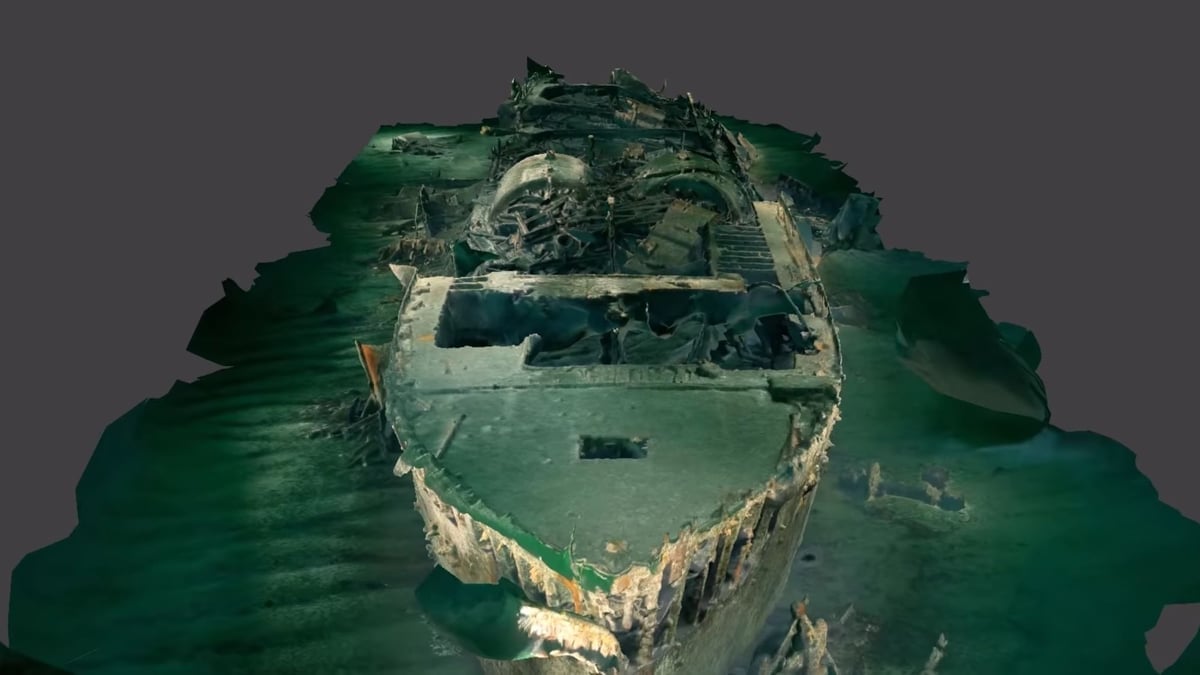
Agisoft’s Metashape is powerful photogrammetry software used for the processing of images in order to reconstruct an object, terrain, building, or scene.
Its image combination capabilities are rather advanced for the average user, as they enable the creation of dense point clouds, textured polygonal models, geo-linked orthophotos, and digital terrain models (DTM). In other words, it’s capable of handling most scanning jobs related to geographic information systems, advanced land surveying, and environment reconstruction (with textures and surfaces), but it can also be used in the gaming and filming industries to create special effects.
Additionally, it allows multiple data sources to be captured by either a single scanning device (camera) or a collection of cameras that feed the software simultaneously. (The cameras can be both static or moving.) Based on each setup, and depending on the desired application, Metashape will analyze the data sets and reconstruct the scene to the desired specifications.
It’s worth noting that these features aren’t available in all versions of the software. There are two basic licensing schemes: Professional and Standard. There are, however, alternative buying options for these licenses. Either can be bought as a Node-Locked License, allowing only one device to use the software, but only the Professional version can be bought with a Floating License, which allows for a variety of users. A 30-day free trial is available for either, and those attending or employed at recognized schools can purchase discounted versions of either license. Educational licenses don’t differ in terms of features, but can’t be used commercially.
- Price: Free 30-day trial; Standard Edition at ~$180 (~$59 educational version); Professional Edition at ~$3,500 (~$549 educational version); floating license available by quote or from resellers
- Application: Photogrammetry
- Learning curve: Medium
- Strong points: Lots of features, high accuracy
3D Zephyr
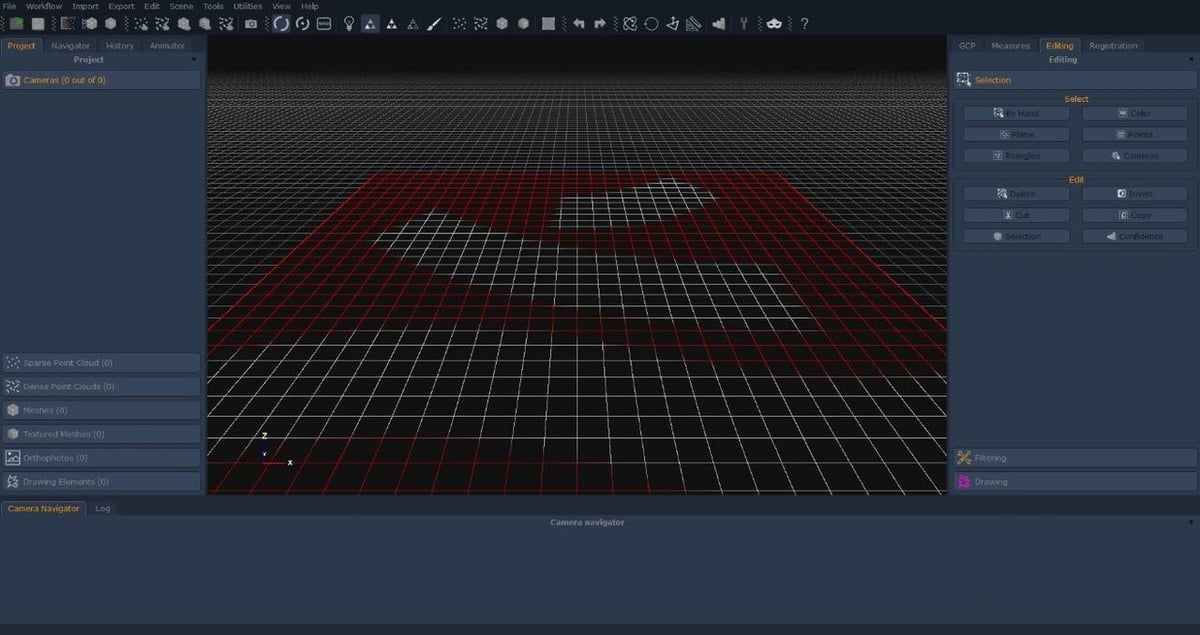
3DF Zephyr is software that can reconstruct an object from a series of photos using photogrammetry techniques. The source of the images isn’t restrictive, so it can process photos taken from UAVs (drones), mobile phones, and regular or 360° cameras.
The software comes in four different versions (free, Lite, 30-day, and full version), which are each individually suitable to a number of applications.
The free version will be more interesting for novice 3D scanning users, and the normal version is better for advanced users. A basic differentiating point between the versions is the number of pictures that it can process (which affects the quality of the output mesh).
The UI of the software is pleasant and rather easy to navigate, making it appealing for newcomers. More experienced users will also find themselves comfortable, as all necessary options are accessible through a system of menus. 3DF Zephyr also has a list of tutorials and an active community.
- Price: Free version; Lite version for ~$220; 30-day full version ~$280; full version for ~$4,600
- Application: Photogrammetry
- Learning curve: Medium
- Strong points: Suitable for most applications
Geomagic Design X
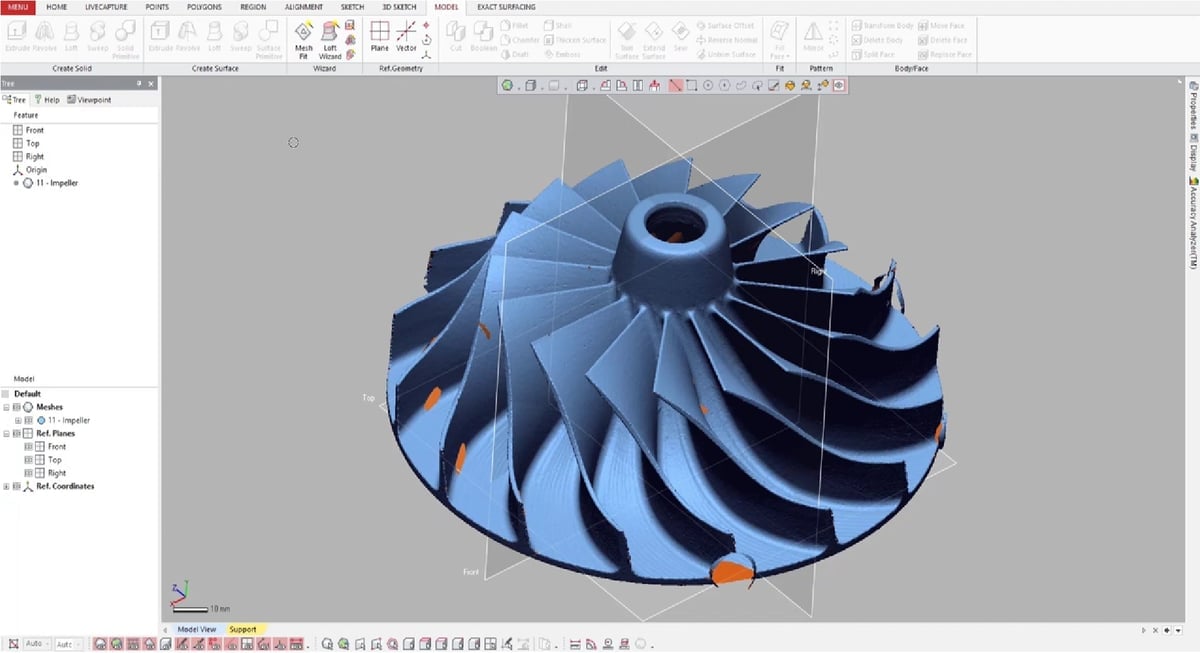
Geomagic Design X from Oqton is professional software – something that’s reflected not only in its price but also its features and capabilities.
The software is marketed as a reverse engineering platform; this refers to the process of scanning and showing information from already existing parts from which you can further develop your own designs. Unlike other options that may only be compatible with same-brand scanners, this option allows you to work with all file formats, meaning that you can have a variety of scanners and only need Geomagic Design X to work on them, including post-processing, no matter their output.
If you’re working with SolidWorks, a useful option to consider is Geomagic Design X’s plug-in, which includes a variety of licenses depending on the intended use.
Additionally, you can work with Geomagic Design X together with Autodesk Inventor, Solid Edge, and PTC Creo, and other 3D scanner software like the previously mentioned Artec Studio.
- Price: $20,000
- Application: Reverse engineering
- Learning curve: Medium
- Strong points: Compatibility with other programs, mesh-to-solid conversion speed
RevEng
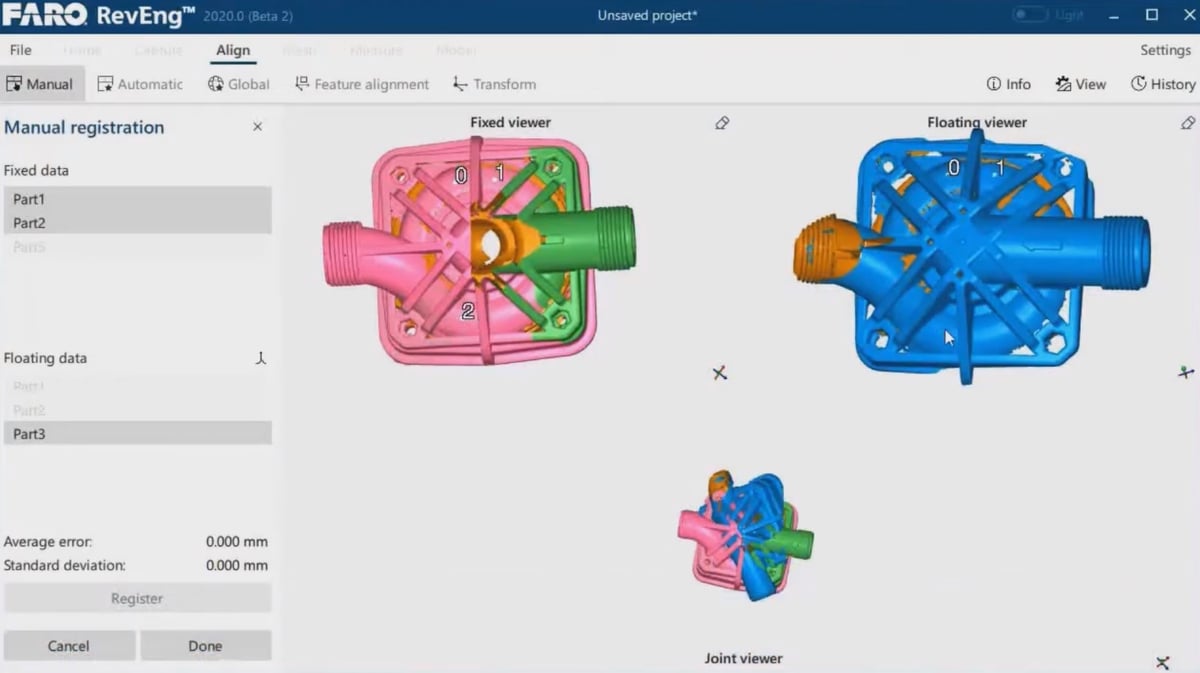
Another platform designed for reverse-engineering applications is FARO’s RevEng software, with which you can use mesh models based on 3D point clouds to continue designing them or 3D print them.
The software includes a Sketch Tool for automatic NURBS (non-uniform rational B-spline) that simplifies the workflow between point clouds and exportable CAD surfaces. Further features include mesh editing and fixing, grid management, and streamlined 3D point capture meant to get rid of overlapping points, among others.
As with most other programs on this list, there’s a free 30-day trial that can be more than useful. As usual, it’s worth checking out the system requirements and, depending on other systems or devices you may want to work with (e.g. Cobalt Design), compatibility with the proper version.
- Price: N/A (free 30-day trial)
- Application: Reverse engineering
- Learning curve: Medium
- Strong points: Sketch Tool for automatic NURBS, UI
GOM Inspect Pro
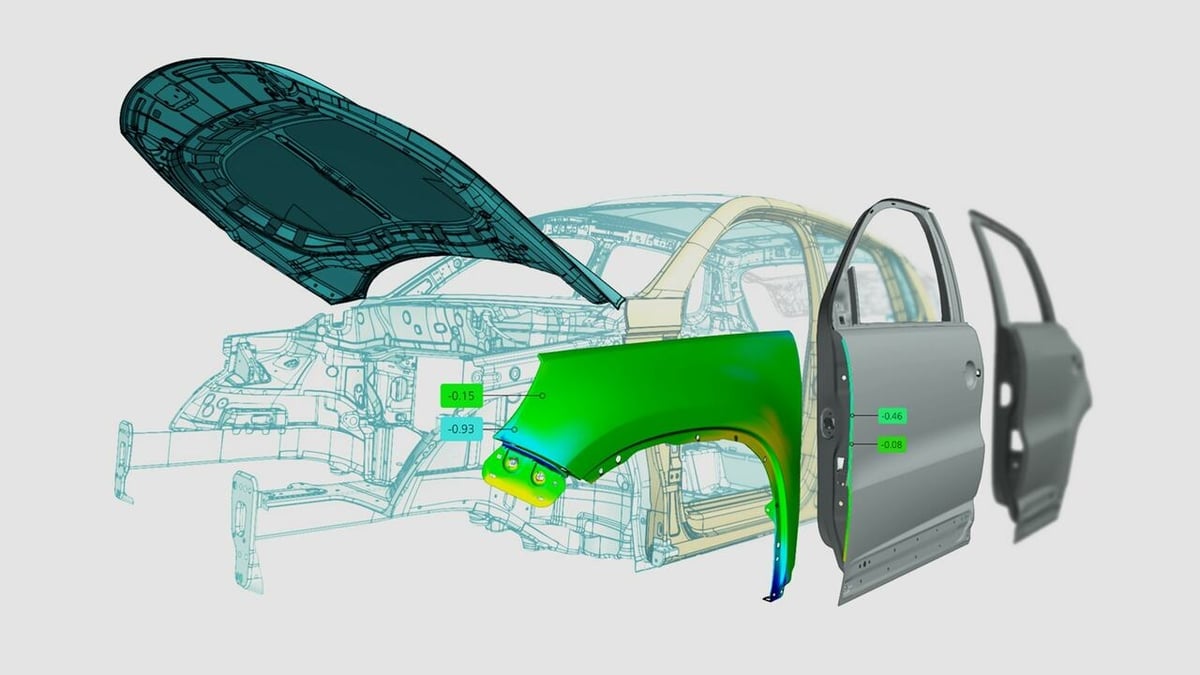
GOM Inspect Pro is a specialized software tool used for inspection and dimensional analysis of 3D objects, or more precisely, the 3D meshes of these 3D objects. Naturally, the 3D meshes are the result of scanning.
GOM is typically used in product development and quality control functions in order to conduct inspections. Scanned objects are compared to a reference product, either as a whole or part by part, which checks for deviations and manufacturing errors. A reference object can, for example, be defined by the blueprint designs.
GOM Inspect Pro offers some other advanced functions. For instance, it possesses full parametric analysis and scripting capabilities, as well as some more industry-specific features, especially for inspection functions (like curved surfaces, deformations, or airfoil and turbine element profiles).
GOM Inspect Pro comes in two versions: professional and enterprise. The difference between the professional and enterprise editions is only the number of licenses available; the software is the same. There is a 30-day free trial for GOM Inspect Pro, and when it expires you may choose to continue with a basic version or purchase a license. GOM Viewer is additionally available and is free to download, but only allows basic inspections of pre-existing files that have to be loaded into the software.
- Price: Quoted by inquiry
- Application: Photogrammetry, scan analysis
- Learning curve: Medium
- Strong points: Inspection, quality control
Post-Scan Essentials
You’ve scanned an object, now what? The next two options have something to offer.
Meshmixer
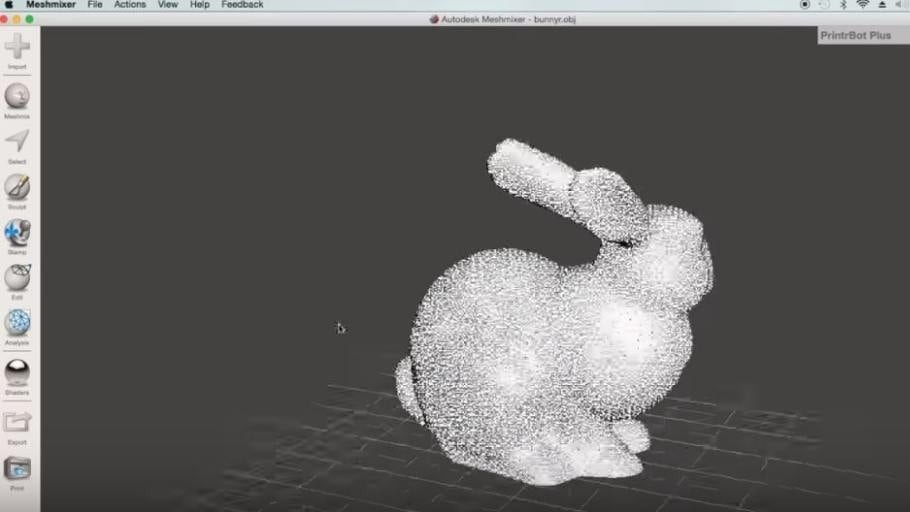
Meshmixer is a free tool from Autodesk that has become a favorite program for 3D printing design fans due to its many features and ease of use. It has a large number of practical features for editing and combining meshes, as implied by the name.
With Meshmixer, you can actually create a 3D model, and more importantly, edit, clean up, and correct existing meshes, including the ones that are exported by scanning software.
Its user interface is sleek and modern, and it’s simple to learn, especially if you have some experience with 3D printing or slicing software.
While it may no longer be in development and Autodesk recommends opting for Fusion 360, you can still download and use it.
- Price: Free
- Application: Mesh editing
- Learning curve: Easy
- Strong points: Easy to use
MeshLab

As they claim on their website’s main page, MeshLab is the “open-source system for processing and editing 3D triangular meshes. It provides a set of tools for editing, cleaning, healing, inspecting, rendering, texturing, and converting meshes”. Indeed, MeshLab performs these tasks well, aiming to be the main competitor to Meshixer and Netfabb.
Originating from academic environments, MeshLab has gone through a long development cycle and gives weight to features, rather than appearance. Its list of tools is quite large, although it’s questionable if all of them will be useful to the average user.
MeshLab has good import and export options, plus it copes well with models from all popular CAD software, thus minimizing the need for file conversions. However, it can be rather involved to use, and due to its poor documentation, some users may find it difficult to get their tasks completed efficiently.
- Price: Free
- Application: Mesh editing and repair
- Learning curve: Medium
- Strong points: Nice features, lots of tools, lightweight in terms of hardware
Lead image source: 3D3 Solutions via YouTube
License: The text of "The Best 3D Scanning Software of 2023 (Some Are Free)" by All3DP is licensed under a Creative Commons Attribution 4.0 International License.
